Business Law Assignment: Doctrine of Res Ipsa Loquitur & Negligence
VerifiedAdded on 2021/06/18
|11
|2383
|59
Homework Assignment
AI Summary
This assignment provides a comprehensive analysis of business law, specifically addressing the doctrine of res ipsa loquitur and the principles of negligence. It examines a scenario involving an accident caused by an employee and explores whether the doctrine of res ipsa loquitur can be applied to shift the burden of proof. The analysis delves into the elements required to establish this doctrine, referencing key legal cases such as Byrne v. Boadle and Mahon v. Osborne. The assignment further identifies the arguments and potential defenses related to negligence, evaluating the employer's liability through vicarious liability and the doctor's duty of care. It references landmark cases like Donoghue v. Stevenson and Hedley Byrne & Co Ltd v. Heller & Partners Ltd to establish the duty of care, breach of duty, and causation. The document concludes by assessing the possibility of contributory negligence and the application of the 'but for' test, providing a thorough legal analysis of the situation.
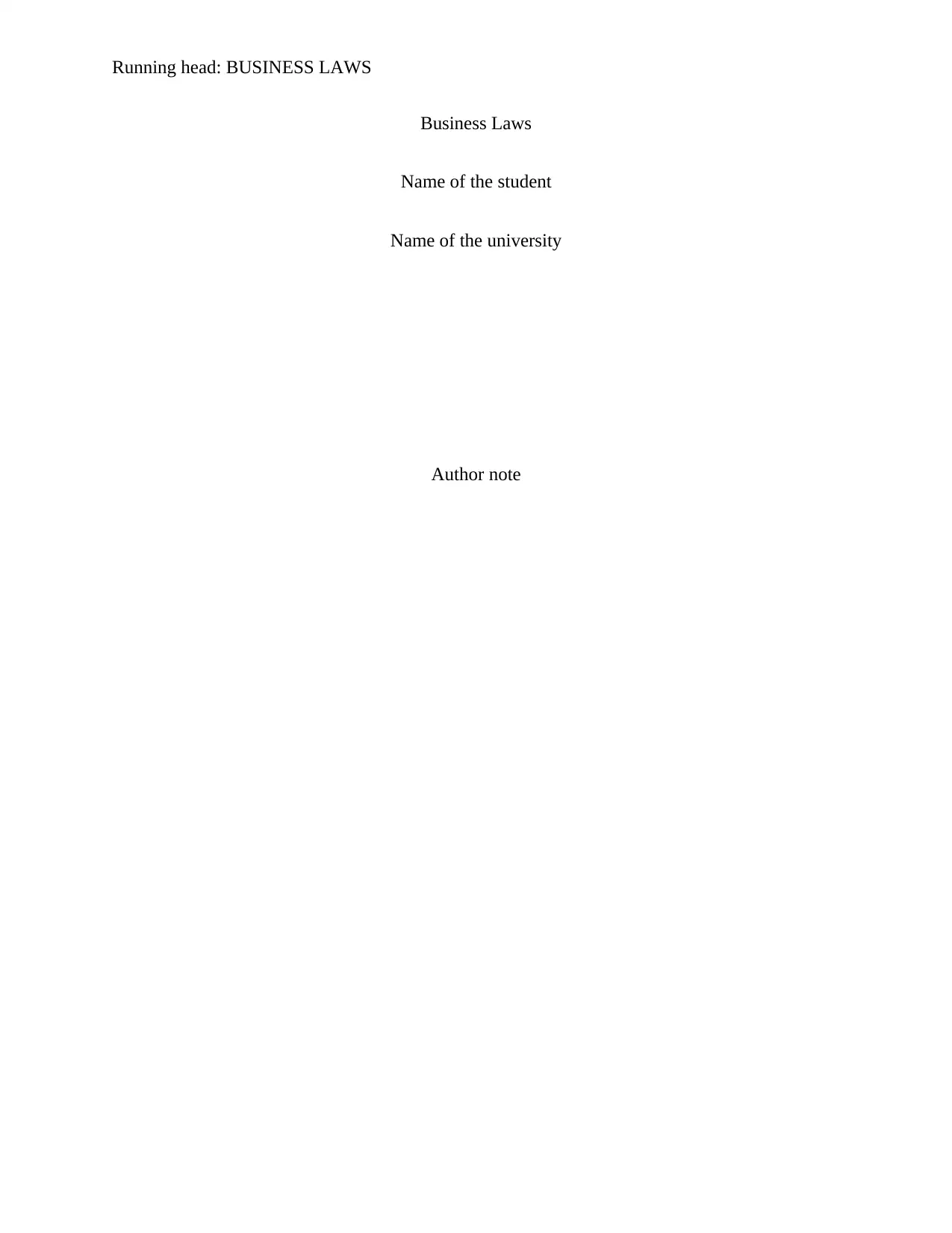
Running head: BUSINESS LAWS
Business Laws
Name of the student
Name of the university
Author note
Business Laws
Name of the student
Name of the university
Author note
Secure Best Marks with AI Grader
Need help grading? Try our AI Grader for instant feedback on your assignments.
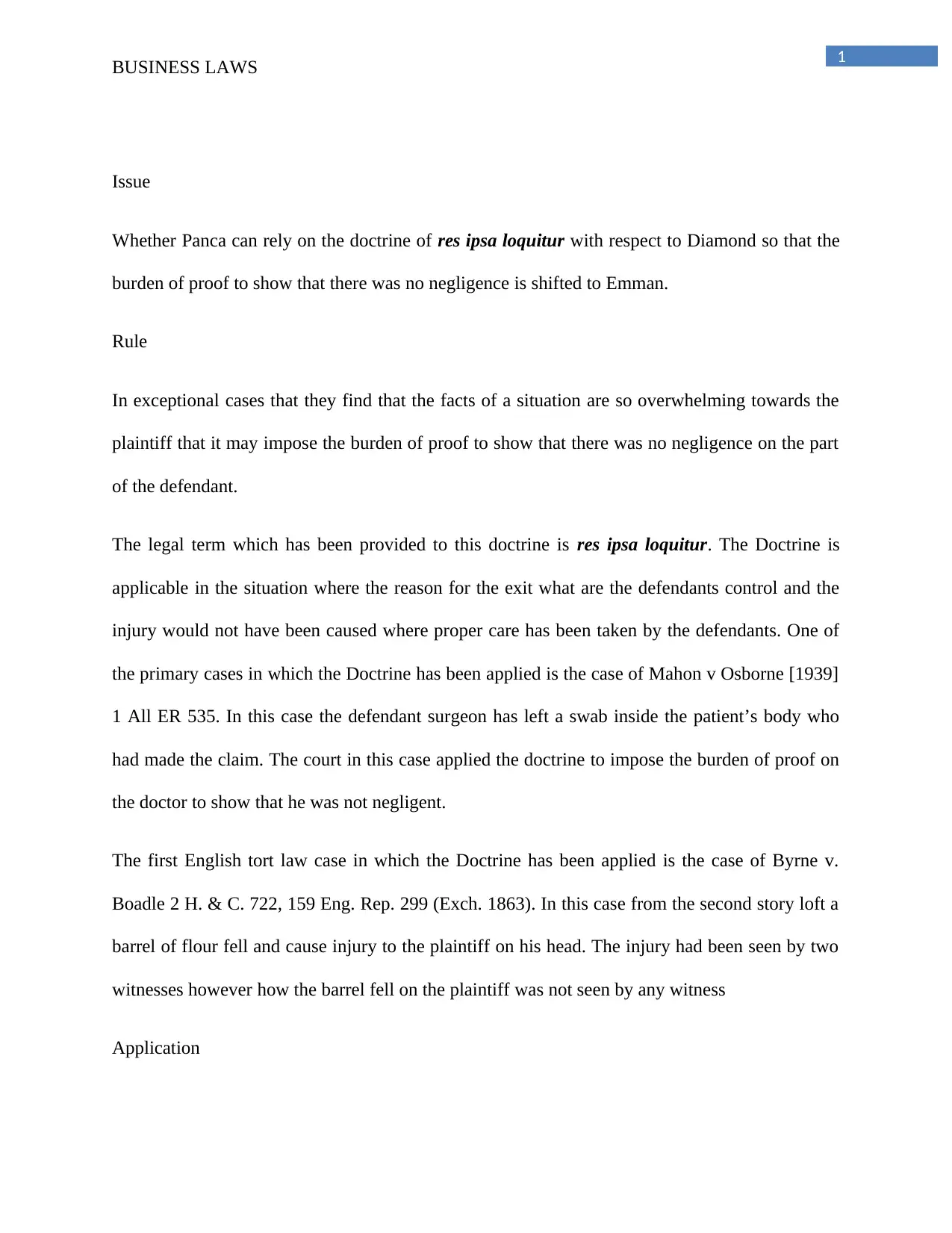
1
BUSINESS LAWS
Issue
Whether Panca can rely on the doctrine of res ipsa loquitur with respect to Diamond so that the
burden of proof to show that there was no negligence is shifted to Emman.
Rule
In exceptional cases that they find that the facts of a situation are so overwhelming towards the
plaintiff that it may impose the burden of proof to show that there was no negligence on the part
of the defendant.
The legal term which has been provided to this doctrine is res ipsa loquitur. The Doctrine is
applicable in the situation where the reason for the exit what are the defendants control and the
injury would not have been caused where proper care has been taken by the defendants. One of
the primary cases in which the Doctrine has been applied is the case of Mahon v Osborne [1939]
1 All ER 535. In this case the defendant surgeon has left a swab inside the patient’s body who
had made the claim. The court in this case applied the doctrine to impose the burden of proof on
the doctor to show that he was not negligent.
The first English tort law case in which the Doctrine has been applied is the case of Byrne v.
Boadle 2 H. & C. 722, 159 Eng. Rep. 299 (Exch. 1863). In this case from the second story loft a
barrel of flour fell and cause injury to the plaintiff on his head. The injury had been seen by two
witnesses however how the barrel fell on the plaintiff was not seen by any witness
Application
BUSINESS LAWS
Issue
Whether Panca can rely on the doctrine of res ipsa loquitur with respect to Diamond so that the
burden of proof to show that there was no negligence is shifted to Emman.
Rule
In exceptional cases that they find that the facts of a situation are so overwhelming towards the
plaintiff that it may impose the burden of proof to show that there was no negligence on the part
of the defendant.
The legal term which has been provided to this doctrine is res ipsa loquitur. The Doctrine is
applicable in the situation where the reason for the exit what are the defendants control and the
injury would not have been caused where proper care has been taken by the defendants. One of
the primary cases in which the Doctrine has been applied is the case of Mahon v Osborne [1939]
1 All ER 535. In this case the defendant surgeon has left a swab inside the patient’s body who
had made the claim. The court in this case applied the doctrine to impose the burden of proof on
the doctor to show that he was not negligent.
The first English tort law case in which the Doctrine has been applied is the case of Byrne v.
Boadle 2 H. & C. 722, 159 Eng. Rep. 299 (Exch. 1863). In this case from the second story loft a
barrel of flour fell and cause injury to the plaintiff on his head. The injury had been seen by two
witnesses however how the barrel fell on the plaintiff was not seen by any witness
Application
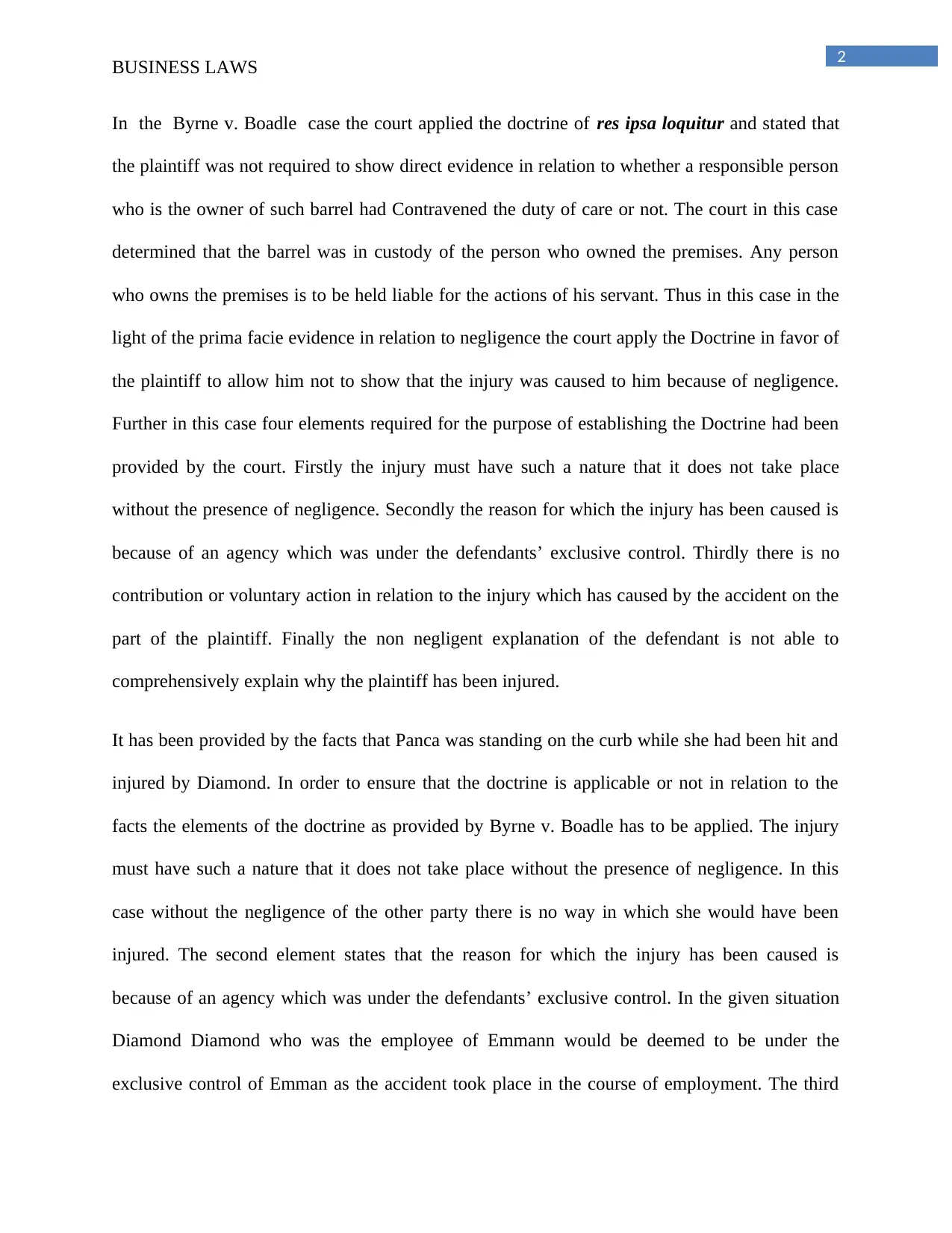
2
BUSINESS LAWS
In the Byrne v. Boadle case the court applied the doctrine of res ipsa loquitur and stated that
the plaintiff was not required to show direct evidence in relation to whether a responsible person
who is the owner of such barrel had Contravened the duty of care or not. The court in this case
determined that the barrel was in custody of the person who owned the premises. Any person
who owns the premises is to be held liable for the actions of his servant. Thus in this case in the
light of the prima facie evidence in relation to negligence the court apply the Doctrine in favor of
the plaintiff to allow him not to show that the injury was caused to him because of negligence.
Further in this case four elements required for the purpose of establishing the Doctrine had been
provided by the court. Firstly the injury must have such a nature that it does not take place
without the presence of negligence. Secondly the reason for which the injury has been caused is
because of an agency which was under the defendants’ exclusive control. Thirdly there is no
contribution or voluntary action in relation to the injury which has caused by the accident on the
part of the plaintiff. Finally the non negligent explanation of the defendant is not able to
comprehensively explain why the plaintiff has been injured.
It has been provided by the facts that Panca was standing on the curb while she had been hit and
injured by Diamond. In order to ensure that the doctrine is applicable or not in relation to the
facts the elements of the doctrine as provided by Byrne v. Boadle has to be applied. The injury
must have such a nature that it does not take place without the presence of negligence. In this
case without the negligence of the other party there is no way in which she would have been
injured. The second element states that the reason for which the injury has been caused is
because of an agency which was under the defendants’ exclusive control. In the given situation
Diamond Diamond who was the employee of Emmann would be deemed to be under the
exclusive control of Emman as the accident took place in the course of employment. The third
BUSINESS LAWS
In the Byrne v. Boadle case the court applied the doctrine of res ipsa loquitur and stated that
the plaintiff was not required to show direct evidence in relation to whether a responsible person
who is the owner of such barrel had Contravened the duty of care or not. The court in this case
determined that the barrel was in custody of the person who owned the premises. Any person
who owns the premises is to be held liable for the actions of his servant. Thus in this case in the
light of the prima facie evidence in relation to negligence the court apply the Doctrine in favor of
the plaintiff to allow him not to show that the injury was caused to him because of negligence.
Further in this case four elements required for the purpose of establishing the Doctrine had been
provided by the court. Firstly the injury must have such a nature that it does not take place
without the presence of negligence. Secondly the reason for which the injury has been caused is
because of an agency which was under the defendants’ exclusive control. Thirdly there is no
contribution or voluntary action in relation to the injury which has caused by the accident on the
part of the plaintiff. Finally the non negligent explanation of the defendant is not able to
comprehensively explain why the plaintiff has been injured.
It has been provided by the facts that Panca was standing on the curb while she had been hit and
injured by Diamond. In order to ensure that the doctrine is applicable or not in relation to the
facts the elements of the doctrine as provided by Byrne v. Boadle has to be applied. The injury
must have such a nature that it does not take place without the presence of negligence. In this
case without the negligence of the other party there is no way in which she would have been
injured. The second element states that the reason for which the injury has been caused is
because of an agency which was under the defendants’ exclusive control. In the given situation
Diamond Diamond who was the employee of Emmann would be deemed to be under the
exclusive control of Emman as the accident took place in the course of employment. The third
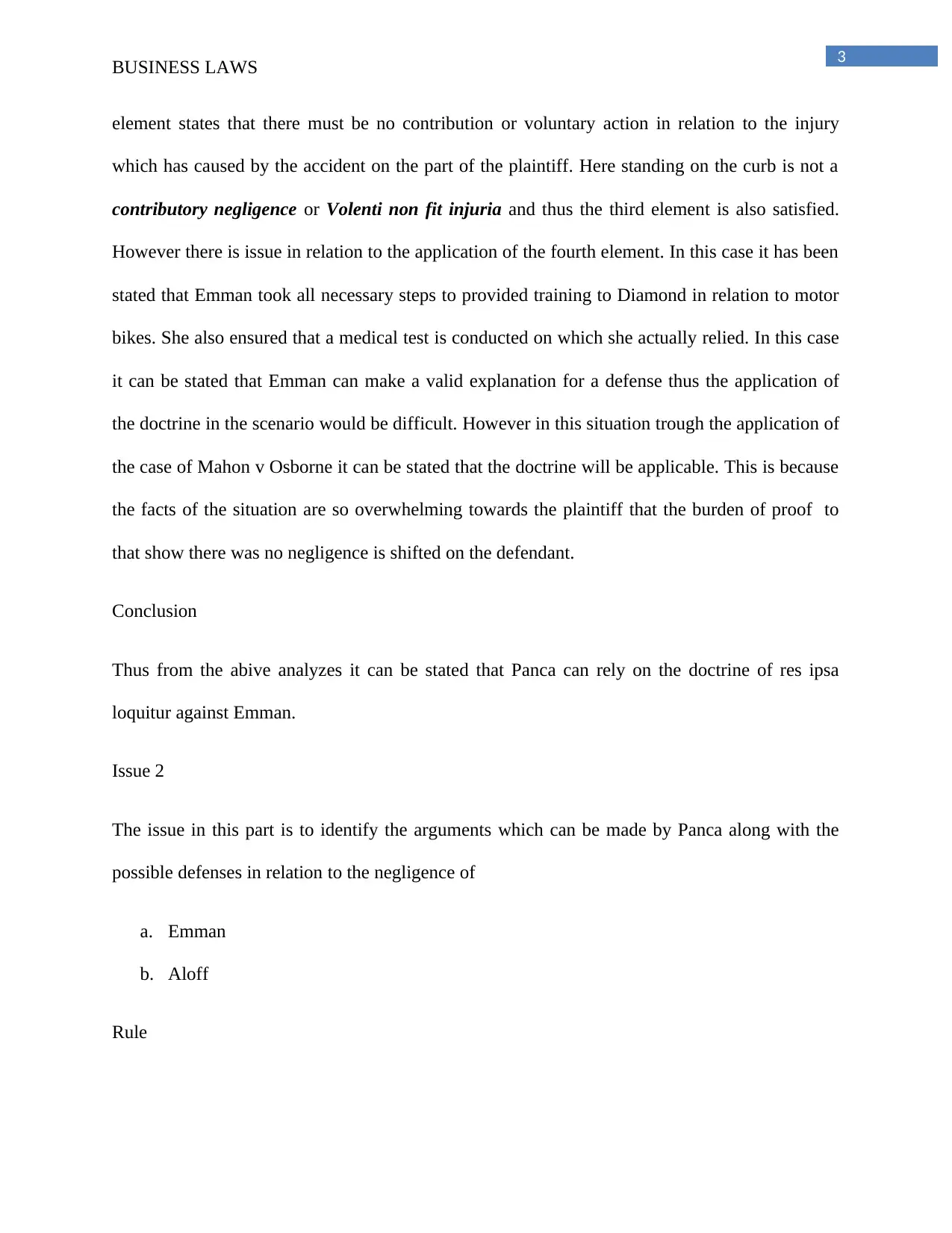
3
BUSINESS LAWS
element states that there must be no contribution or voluntary action in relation to the injury
which has caused by the accident on the part of the plaintiff. Here standing on the curb is not a
contributory negligence or Volenti non fit injuria and thus the third element is also satisfied.
However there is issue in relation to the application of the fourth element. In this case it has been
stated that Emman took all necessary steps to provided training to Diamond in relation to motor
bikes. She also ensured that a medical test is conducted on which she actually relied. In this case
it can be stated that Emman can make a valid explanation for a defense thus the application of
the doctrine in the scenario would be difficult. However in this situation trough the application of
the case of Mahon v Osborne it can be stated that the doctrine will be applicable. This is because
the facts of the situation are so overwhelming towards the plaintiff that the burden of proof to
that show there was no negligence is shifted on the defendant.
Conclusion
Thus from the abive analyzes it can be stated that Panca can rely on the doctrine of res ipsa
loquitur against Emman.
Issue 2
The issue in this part is to identify the arguments which can be made by Panca along with the
possible defenses in relation to the negligence of
a. Emman
b. Aloff
Rule
BUSINESS LAWS
element states that there must be no contribution or voluntary action in relation to the injury
which has caused by the accident on the part of the plaintiff. Here standing on the curb is not a
contributory negligence or Volenti non fit injuria and thus the third element is also satisfied.
However there is issue in relation to the application of the fourth element. In this case it has been
stated that Emman took all necessary steps to provided training to Diamond in relation to motor
bikes. She also ensured that a medical test is conducted on which she actually relied. In this case
it can be stated that Emman can make a valid explanation for a defense thus the application of
the doctrine in the scenario would be difficult. However in this situation trough the application of
the case of Mahon v Osborne it can be stated that the doctrine will be applicable. This is because
the facts of the situation are so overwhelming towards the plaintiff that the burden of proof to
that show there was no negligence is shifted on the defendant.
Conclusion
Thus from the abive analyzes it can be stated that Panca can rely on the doctrine of res ipsa
loquitur against Emman.
Issue 2
The issue in this part is to identify the arguments which can be made by Panca along with the
possible defenses in relation to the negligence of
a. Emman
b. Aloff
Rule
Secure Best Marks with AI Grader
Need help grading? Try our AI Grader for instant feedback on your assignments.
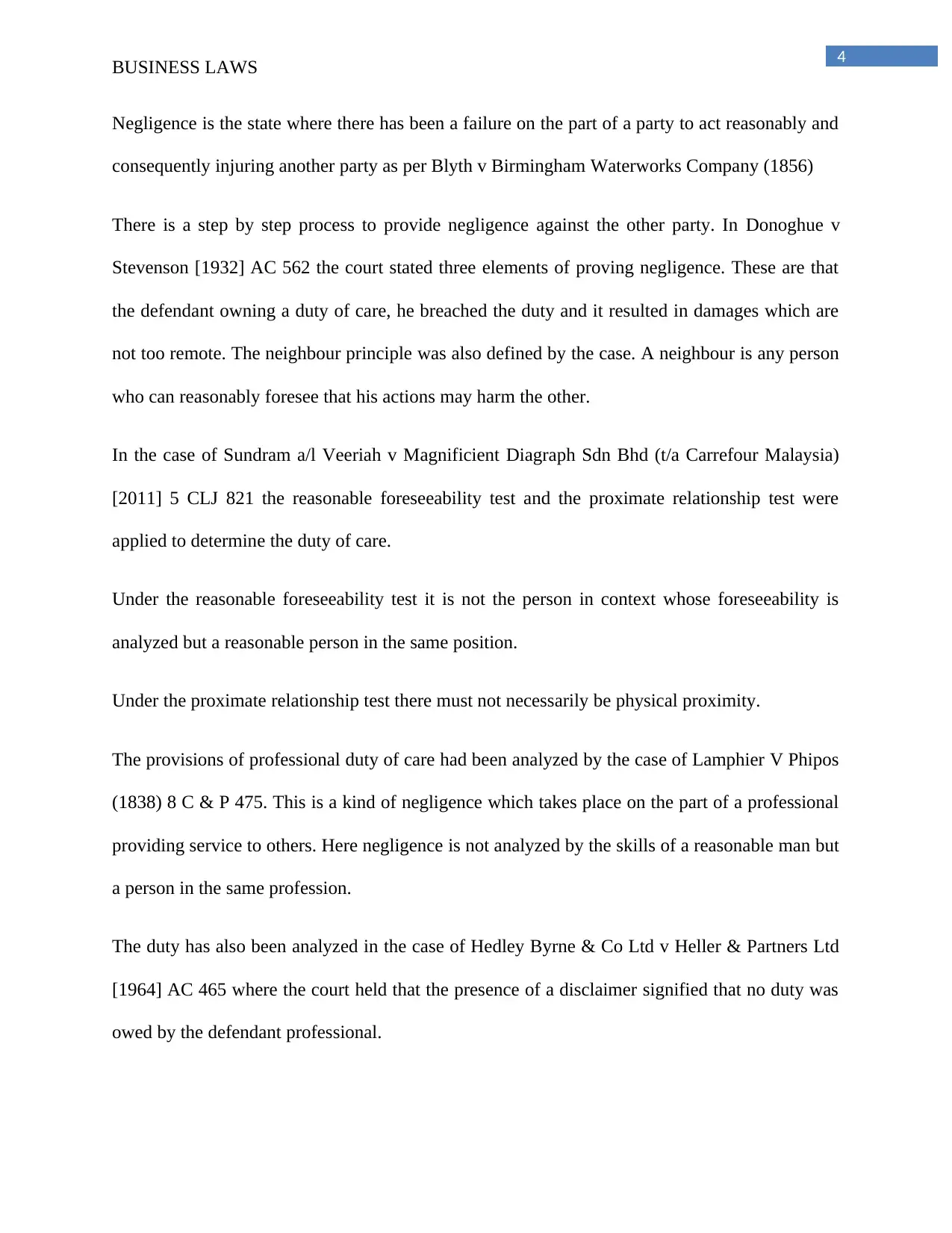
4
BUSINESS LAWS
Negligence is the state where there has been a failure on the part of a party to act reasonably and
consequently injuring another party as per Blyth v Birmingham Waterworks Company (1856)
There is a step by step process to provide negligence against the other party. In Donoghue v
Stevenson [1932] AC 562 the court stated three elements of proving negligence. These are that
the defendant owning a duty of care, he breached the duty and it resulted in damages which are
not too remote. The neighbour principle was also defined by the case. A neighbour is any person
who can reasonably foresee that his actions may harm the other.
In the case of Sundram a/l Veeriah v Magnificient Diagraph Sdn Bhd (t/a Carrefour Malaysia)
[2011] 5 CLJ 821 the reasonable foreseeability test and the proximate relationship test were
applied to determine the duty of care.
Under the reasonable foreseeability test it is not the person in context whose foreseeability is
analyzed but a reasonable person in the same position.
Under the proximate relationship test there must not necessarily be physical proximity.
The provisions of professional duty of care had been analyzed by the case of Lamphier V Phipos
(1838) 8 C & P 475. This is a kind of negligence which takes place on the part of a professional
providing service to others. Here negligence is not analyzed by the skills of a reasonable man but
a person in the same profession.
The duty has also been analyzed in the case of Hedley Byrne & Co Ltd v Heller & Partners Ltd
[1964] AC 465 where the court held that the presence of a disclaimer signified that no duty was
owed by the defendant professional.
BUSINESS LAWS
Negligence is the state where there has been a failure on the part of a party to act reasonably and
consequently injuring another party as per Blyth v Birmingham Waterworks Company (1856)
There is a step by step process to provide negligence against the other party. In Donoghue v
Stevenson [1932] AC 562 the court stated three elements of proving negligence. These are that
the defendant owning a duty of care, he breached the duty and it resulted in damages which are
not too remote. The neighbour principle was also defined by the case. A neighbour is any person
who can reasonably foresee that his actions may harm the other.
In the case of Sundram a/l Veeriah v Magnificient Diagraph Sdn Bhd (t/a Carrefour Malaysia)
[2011] 5 CLJ 821 the reasonable foreseeability test and the proximate relationship test were
applied to determine the duty of care.
Under the reasonable foreseeability test it is not the person in context whose foreseeability is
analyzed but a reasonable person in the same position.
Under the proximate relationship test there must not necessarily be physical proximity.
The provisions of professional duty of care had been analyzed by the case of Lamphier V Phipos
(1838) 8 C & P 475. This is a kind of negligence which takes place on the part of a professional
providing service to others. Here negligence is not analyzed by the skills of a reasonable man but
a person in the same profession.
The duty has also been analyzed in the case of Hedley Byrne & Co Ltd v Heller & Partners Ltd
[1964] AC 465 where the court held that the presence of a disclaimer signified that no duty was
owed by the defendant professional.
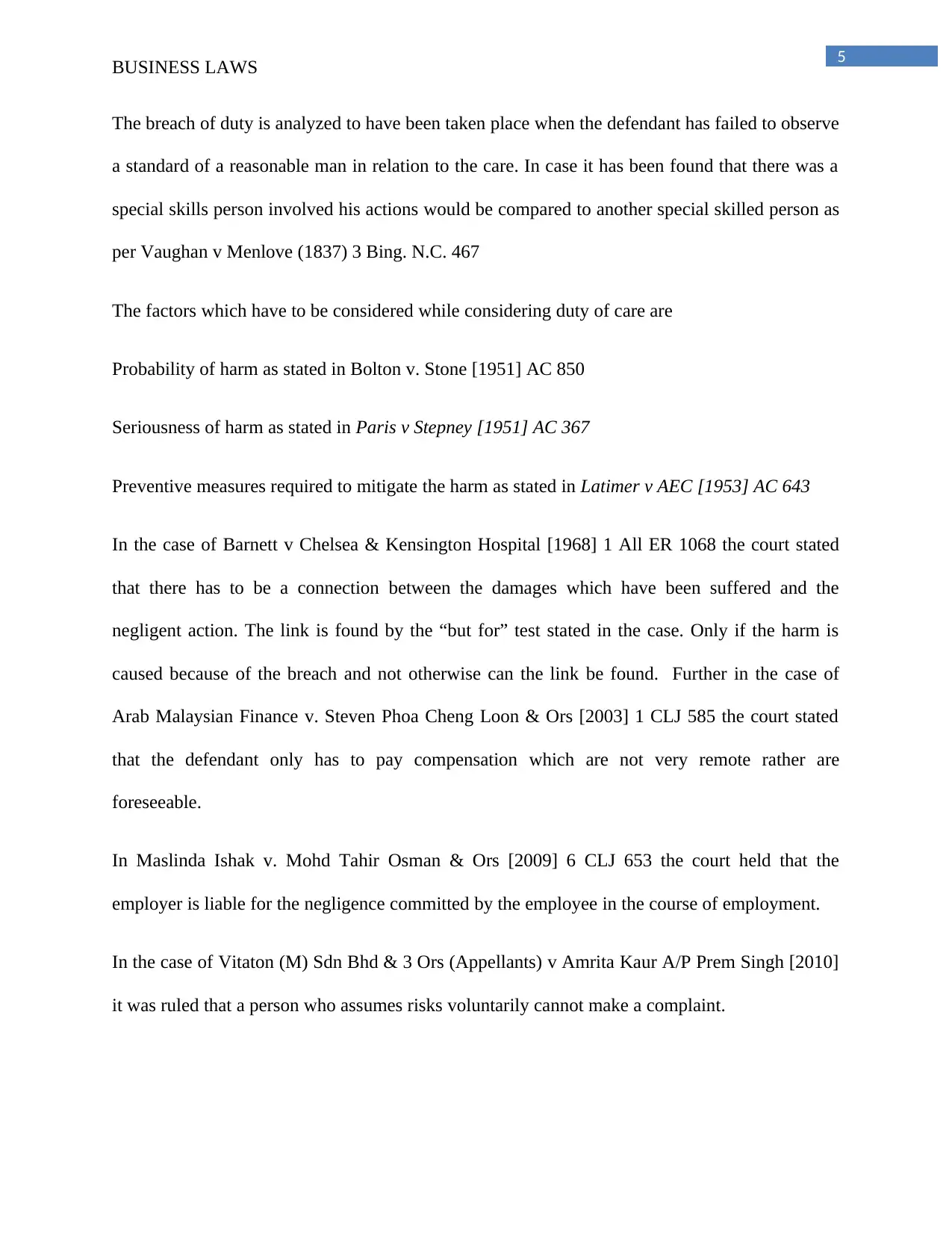
5
BUSINESS LAWS
The breach of duty is analyzed to have been taken place when the defendant has failed to observe
a standard of a reasonable man in relation to the care. In case it has been found that there was a
special skills person involved his actions would be compared to another special skilled person as
per Vaughan v Menlove (1837) 3 Bing. N.C. 467
The factors which have to be considered while considering duty of care are
Probability of harm as stated in Bolton v. Stone [1951] AC 850
Seriousness of harm as stated in Paris v Stepney [1951] AC 367
Preventive measures required to mitigate the harm as stated in Latimer v AEC [1953] AC 643
In the case of Barnett v Chelsea & Kensington Hospital [1968] 1 All ER 1068 the court stated
that there has to be a connection between the damages which have been suffered and the
negligent action. The link is found by the “but for” test stated in the case. Only if the harm is
caused because of the breach and not otherwise can the link be found. Further in the case of
Arab Malaysian Finance v. Steven Phoa Cheng Loon & Ors [2003] 1 CLJ 585 the court stated
that the defendant only has to pay compensation which are not very remote rather are
foreseeable.
In Maslinda Ishak v. Mohd Tahir Osman & Ors [2009] 6 CLJ 653 the court held that the
employer is liable for the negligence committed by the employee in the course of employment.
In the case of Vitaton (M) Sdn Bhd & 3 Ors (Appellants) v Amrita Kaur A/P Prem Singh [2010]
it was ruled that a person who assumes risks voluntarily cannot make a complaint.
BUSINESS LAWS
The breach of duty is analyzed to have been taken place when the defendant has failed to observe
a standard of a reasonable man in relation to the care. In case it has been found that there was a
special skills person involved his actions would be compared to another special skilled person as
per Vaughan v Menlove (1837) 3 Bing. N.C. 467
The factors which have to be considered while considering duty of care are
Probability of harm as stated in Bolton v. Stone [1951] AC 850
Seriousness of harm as stated in Paris v Stepney [1951] AC 367
Preventive measures required to mitigate the harm as stated in Latimer v AEC [1953] AC 643
In the case of Barnett v Chelsea & Kensington Hospital [1968] 1 All ER 1068 the court stated
that there has to be a connection between the damages which have been suffered and the
negligent action. The link is found by the “but for” test stated in the case. Only if the harm is
caused because of the breach and not otherwise can the link be found. Further in the case of
Arab Malaysian Finance v. Steven Phoa Cheng Loon & Ors [2003] 1 CLJ 585 the court stated
that the defendant only has to pay compensation which are not very remote rather are
foreseeable.
In Maslinda Ishak v. Mohd Tahir Osman & Ors [2009] 6 CLJ 653 the court held that the
employer is liable for the negligence committed by the employee in the course of employment.
In the case of Vitaton (M) Sdn Bhd & 3 Ors (Appellants) v Amrita Kaur A/P Prem Singh [2010]
it was ruled that a person who assumes risks voluntarily cannot make a complaint.
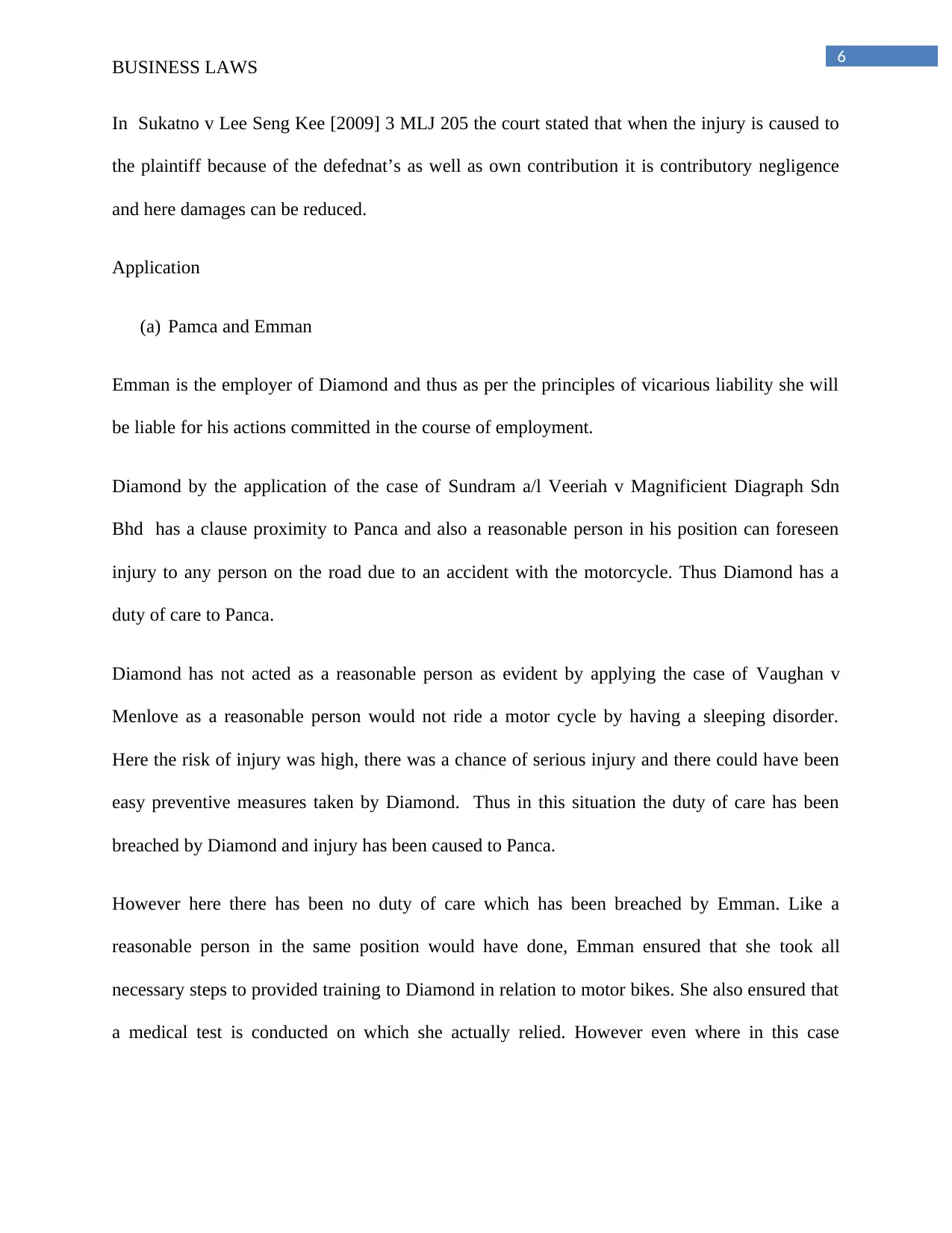
6
BUSINESS LAWS
In Sukatno v Lee Seng Kee [2009] 3 MLJ 205 the court stated that when the injury is caused to
the plaintiff because of the defednat’s as well as own contribution it is contributory negligence
and here damages can be reduced.
Application
(a) Pamca and Emman
Emman is the employer of Diamond and thus as per the principles of vicarious liability she will
be liable for his actions committed in the course of employment.
Diamond by the application of the case of Sundram a/l Veeriah v Magnificient Diagraph Sdn
Bhd has a clause proximity to Panca and also a reasonable person in his position can foreseen
injury to any person on the road due to an accident with the motorcycle. Thus Diamond has a
duty of care to Panca.
Diamond has not acted as a reasonable person as evident by applying the case of Vaughan v
Menlove as a reasonable person would not ride a motor cycle by having a sleeping disorder.
Here the risk of injury was high, there was a chance of serious injury and there could have been
easy preventive measures taken by Diamond. Thus in this situation the duty of care has been
breached by Diamond and injury has been caused to Panca.
However here there has been no duty of care which has been breached by Emman. Like a
reasonable person in the same position would have done, Emman ensured that she took all
necessary steps to provided training to Diamond in relation to motor bikes. She also ensured that
a medical test is conducted on which she actually relied. However even where in this case
BUSINESS LAWS
In Sukatno v Lee Seng Kee [2009] 3 MLJ 205 the court stated that when the injury is caused to
the plaintiff because of the defednat’s as well as own contribution it is contributory negligence
and here damages can be reduced.
Application
(a) Pamca and Emman
Emman is the employer of Diamond and thus as per the principles of vicarious liability she will
be liable for his actions committed in the course of employment.
Diamond by the application of the case of Sundram a/l Veeriah v Magnificient Diagraph Sdn
Bhd has a clause proximity to Panca and also a reasonable person in his position can foreseen
injury to any person on the road due to an accident with the motorcycle. Thus Diamond has a
duty of care to Panca.
Diamond has not acted as a reasonable person as evident by applying the case of Vaughan v
Menlove as a reasonable person would not ride a motor cycle by having a sleeping disorder.
Here the risk of injury was high, there was a chance of serious injury and there could have been
easy preventive measures taken by Diamond. Thus in this situation the duty of care has been
breached by Diamond and injury has been caused to Panca.
However here there has been no duty of care which has been breached by Emman. Like a
reasonable person in the same position would have done, Emman ensured that she took all
necessary steps to provided training to Diamond in relation to motor bikes. She also ensured that
a medical test is conducted on which she actually relied. However even where in this case
Paraphrase This Document
Need a fresh take? Get an instant paraphrase of this document with our AI Paraphraser
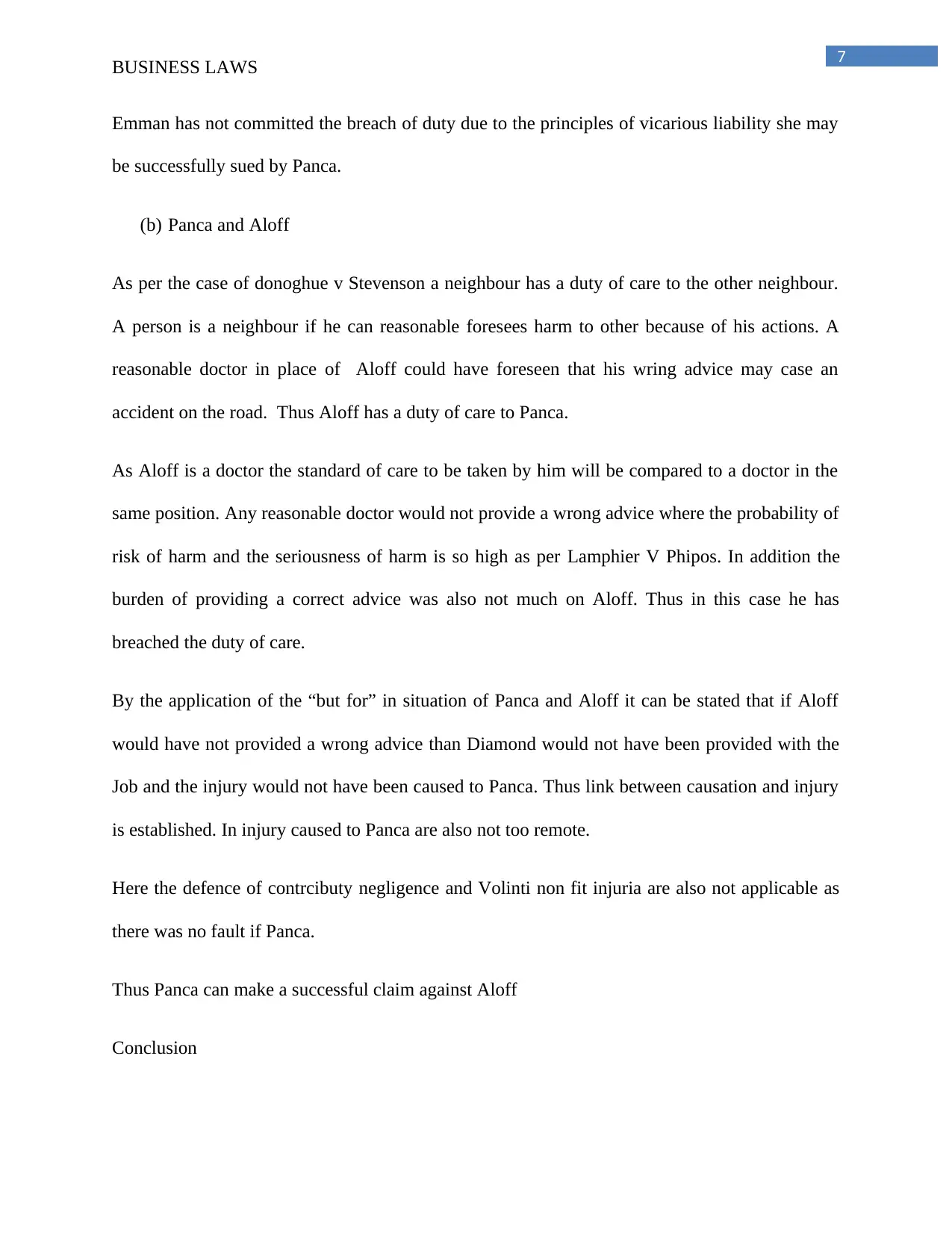
7
BUSINESS LAWS
Emman has not committed the breach of duty due to the principles of vicarious liability she may
be successfully sued by Panca.
(b) Panca and Aloff
As per the case of donoghue v Stevenson a neighbour has a duty of care to the other neighbour.
A person is a neighbour if he can reasonable foresees harm to other because of his actions. A
reasonable doctor in place of Aloff could have foreseen that his wring advice may case an
accident on the road. Thus Aloff has a duty of care to Panca.
As Aloff is a doctor the standard of care to be taken by him will be compared to a doctor in the
same position. Any reasonable doctor would not provide a wrong advice where the probability of
risk of harm and the seriousness of harm is so high as per Lamphier V Phipos. In addition the
burden of providing a correct advice was also not much on Aloff. Thus in this case he has
breached the duty of care.
By the application of the “but for” in situation of Panca and Aloff it can be stated that if Aloff
would have not provided a wrong advice than Diamond would not have been provided with the
Job and the injury would not have been caused to Panca. Thus link between causation and injury
is established. In injury caused to Panca are also not too remote.
Here the defence of contrcibuty negligence and Volinti non fit injuria are also not applicable as
there was no fault if Panca.
Thus Panca can make a successful claim against Aloff
Conclusion
BUSINESS LAWS
Emman has not committed the breach of duty due to the principles of vicarious liability she may
be successfully sued by Panca.
(b) Panca and Aloff
As per the case of donoghue v Stevenson a neighbour has a duty of care to the other neighbour.
A person is a neighbour if he can reasonable foresees harm to other because of his actions. A
reasonable doctor in place of Aloff could have foreseen that his wring advice may case an
accident on the road. Thus Aloff has a duty of care to Panca.
As Aloff is a doctor the standard of care to be taken by him will be compared to a doctor in the
same position. Any reasonable doctor would not provide a wrong advice where the probability of
risk of harm and the seriousness of harm is so high as per Lamphier V Phipos. In addition the
burden of providing a correct advice was also not much on Aloff. Thus in this case he has
breached the duty of care.
By the application of the “but for” in situation of Panca and Aloff it can be stated that if Aloff
would have not provided a wrong advice than Diamond would not have been provided with the
Job and the injury would not have been caused to Panca. Thus link between causation and injury
is established. In injury caused to Panca are also not too remote.
Here the defence of contrcibuty negligence and Volinti non fit injuria are also not applicable as
there was no fault if Panca.
Thus Panca can make a successful claim against Aloff
Conclusion
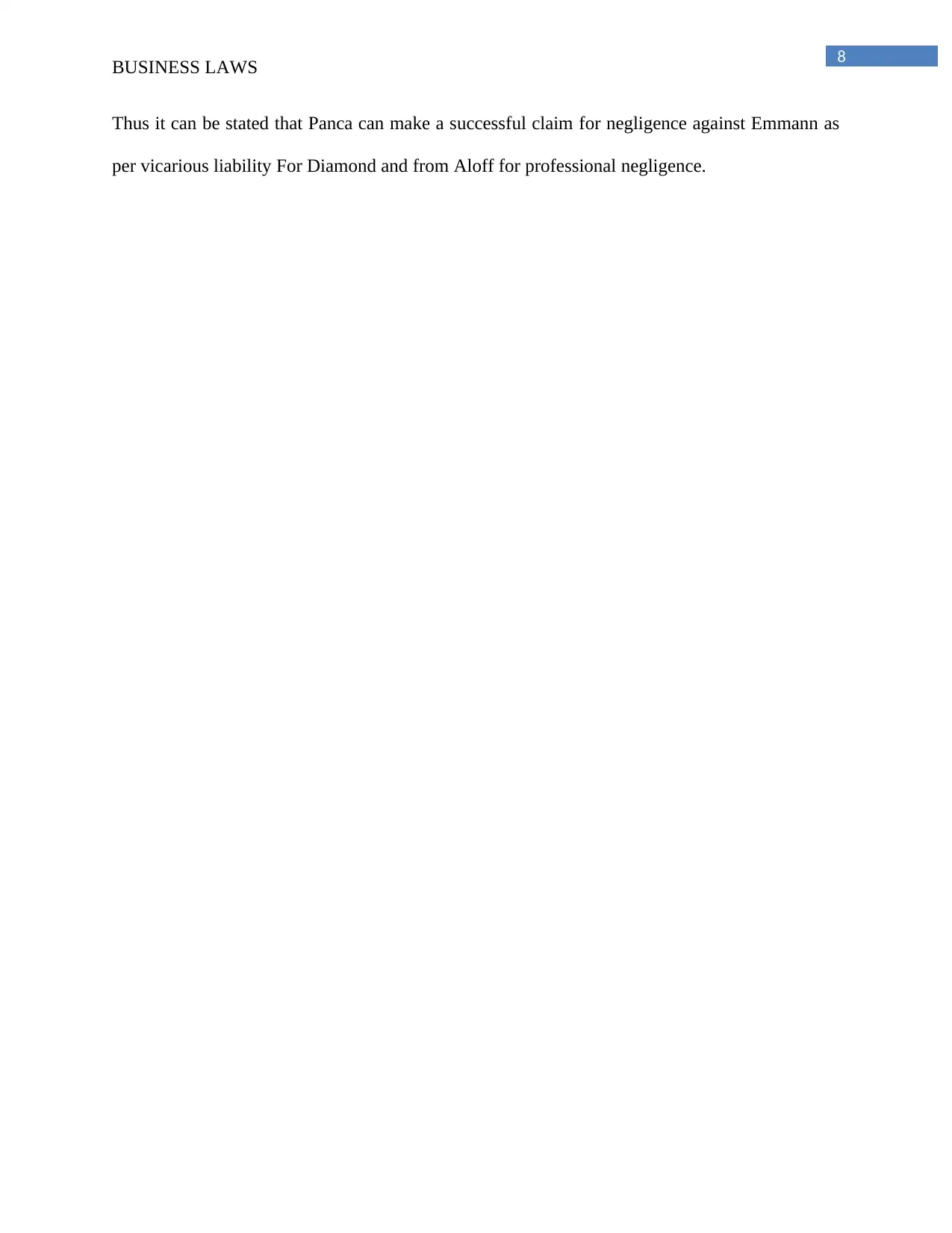
8
BUSINESS LAWS
Thus it can be stated that Panca can make a successful claim for negligence against Emmann as
per vicarious liability For Diamond and from Aloff for professional negligence.
BUSINESS LAWS
Thus it can be stated that Panca can make a successful claim for negligence against Emmann as
per vicarious liability For Diamond and from Aloff for professional negligence.
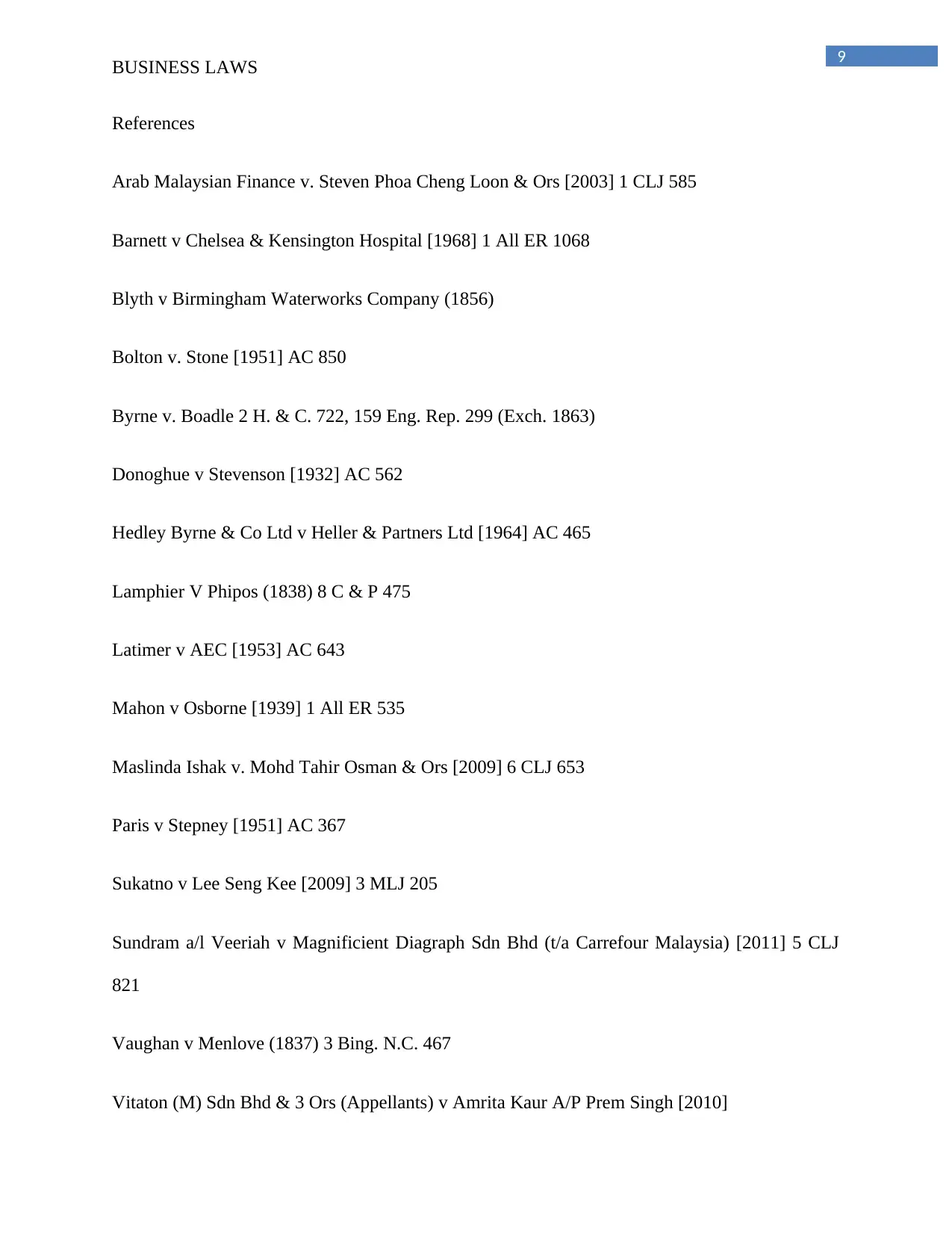
9
BUSINESS LAWS
References
Arab Malaysian Finance v. Steven Phoa Cheng Loon & Ors [2003] 1 CLJ 585
Barnett v Chelsea & Kensington Hospital [1968] 1 All ER 1068
Blyth v Birmingham Waterworks Company (1856)
Bolton v. Stone [1951] AC 850
Byrne v. Boadle 2 H. & C. 722, 159 Eng. Rep. 299 (Exch. 1863)
Donoghue v Stevenson [1932] AC 562
Hedley Byrne & Co Ltd v Heller & Partners Ltd [1964] AC 465
Lamphier V Phipos (1838) 8 C & P 475
Latimer v AEC [1953] AC 643
Mahon v Osborne [1939] 1 All ER 535
Maslinda Ishak v. Mohd Tahir Osman & Ors [2009] 6 CLJ 653
Paris v Stepney [1951] AC 367
Sukatno v Lee Seng Kee [2009] 3 MLJ 205
Sundram a/l Veeriah v Magnificient Diagraph Sdn Bhd (t/a Carrefour Malaysia) [2011] 5 CLJ
821
Vaughan v Menlove (1837) 3 Bing. N.C. 467
Vitaton (M) Sdn Bhd & 3 Ors (Appellants) v Amrita Kaur A/P Prem Singh [2010]
BUSINESS LAWS
References
Arab Malaysian Finance v. Steven Phoa Cheng Loon & Ors [2003] 1 CLJ 585
Barnett v Chelsea & Kensington Hospital [1968] 1 All ER 1068
Blyth v Birmingham Waterworks Company (1856)
Bolton v. Stone [1951] AC 850
Byrne v. Boadle 2 H. & C. 722, 159 Eng. Rep. 299 (Exch. 1863)
Donoghue v Stevenson [1932] AC 562
Hedley Byrne & Co Ltd v Heller & Partners Ltd [1964] AC 465
Lamphier V Phipos (1838) 8 C & P 475
Latimer v AEC [1953] AC 643
Mahon v Osborne [1939] 1 All ER 535
Maslinda Ishak v. Mohd Tahir Osman & Ors [2009] 6 CLJ 653
Paris v Stepney [1951] AC 367
Sukatno v Lee Seng Kee [2009] 3 MLJ 205
Sundram a/l Veeriah v Magnificient Diagraph Sdn Bhd (t/a Carrefour Malaysia) [2011] 5 CLJ
821
Vaughan v Menlove (1837) 3 Bing. N.C. 467
Vitaton (M) Sdn Bhd & 3 Ors (Appellants) v Amrita Kaur A/P Prem Singh [2010]
Secure Best Marks with AI Grader
Need help grading? Try our AI Grader for instant feedback on your assignments.
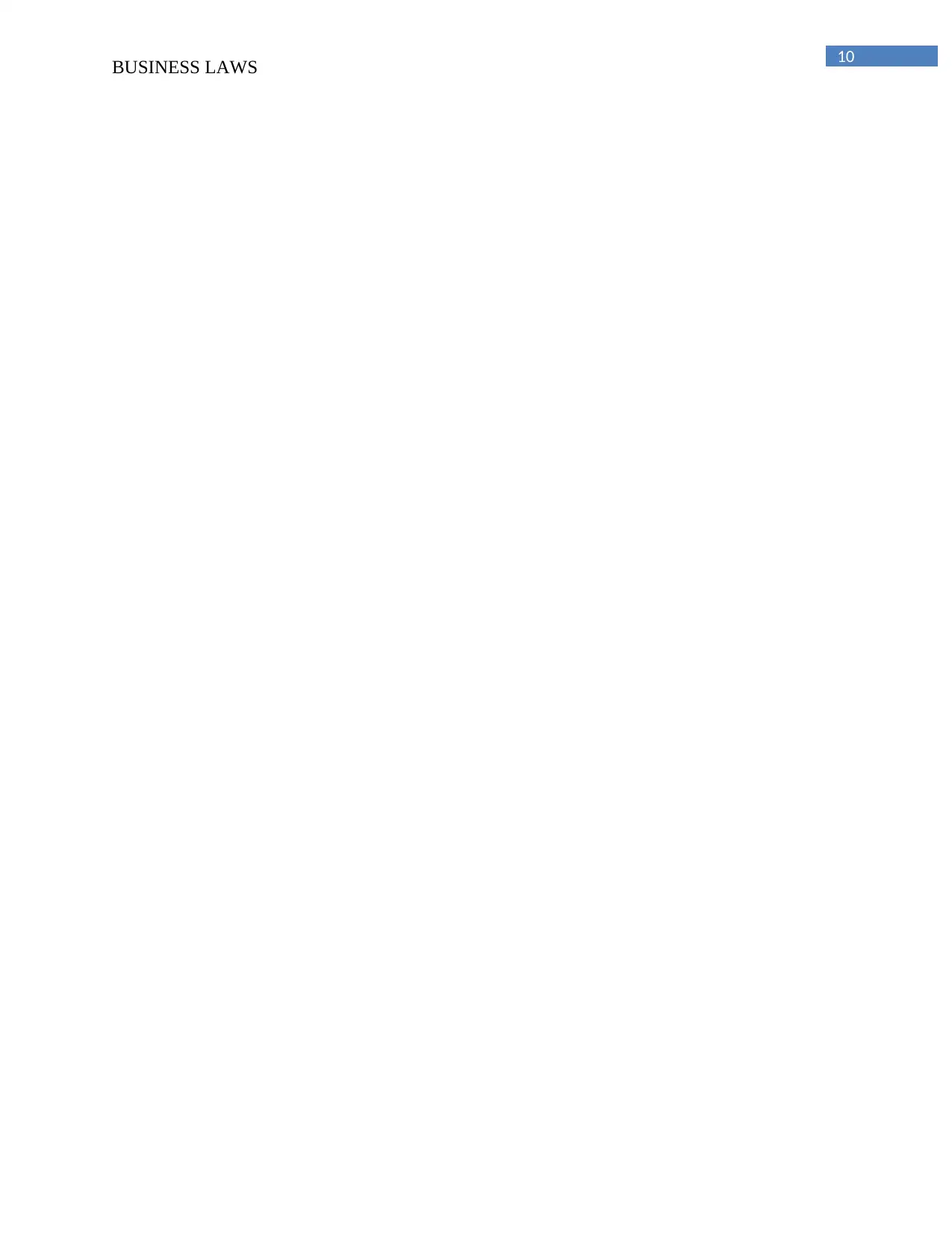
10
BUSINESS LAWS
BUSINESS LAWS
1 out of 11
Related Documents
Your All-in-One AI-Powered Toolkit for Academic Success.
+13062052269
info@desklib.com
Available 24*7 on WhatsApp / Email
![[object Object]](/_next/static/media/star-bottom.7253800d.svg)
Unlock your academic potential
© 2024 | Zucol Services PVT LTD | All rights reserved.





